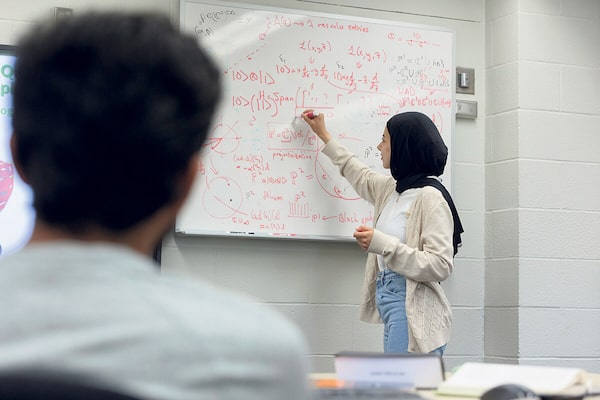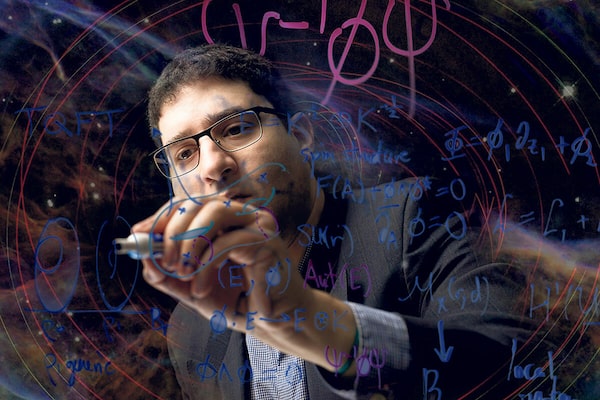
Quantum mathematics can provide insights into the rules governing atomic and subatomic particles with the potential to manipulate the fine structure of materials.SUPPLIED
How can we describe the smallest building blocks that make up matter? What do we know about the interplay between the structure of matter and its behaviour, and how can we use such knowledge to create better materials in the real world? Answers to such questions can be found in quantum mathematics, believes Steven Rayan, quantum researcher and professor in mathematics and statistics at the University of Saskatchewan (USask).
“Quantum science requires a grasp of the rules governing some of the smallest objects in nature, the world of atomic and subatomic particles,” he says. “When we understand these rules, which are largely mathematical in nature, we can possibly bend and break them. Thinking in terms of geometry and shapes can reveal to us where these points of bending and breakage are, thereby allowing us to re-engineer from the inside out everyday materials that we take for granted and turn them into ‘quantum materials’ that behave in entirely unexpected ways.”
Explorations into the fine structure of materials – for example, materials that conduct electricity – often reveal regular patterns, Dr. Rayan explains. “When we look under the hood, we may discover structures that resemble crystals, such as side-by-side squares or hexagons.”

Steven Rayan, quantum researcher and professor in mathematics and statistics at the University of Saskatchewan, sees mathematics as playing a key role in advancing quantum science.SUPPLIED
This may inspire questions about how different shapes may result in different behaviours, he says. “What if we used eight-sided, stop-sign-shaped tiles? Octagons don’t tile nicely, and so we have to be creative. Such explorations could inspire the design of better conductors, for example, to be used in quantum technologies.”
These technologies include “quantum computing, probably the most disruptive and most anticipated technology coming out of quantum science,” Dr. Rayan notes. “And the sheer power of quantum computing brings exciting opportunities.”
The wider adoption of quantum computers is limited at the moment by the fact that their components, in some instances, “must be cooled to about minus 273 degrees Celsius. We’re talking colder than space – and that’s not scalable in the long run, not even in Saskatchewan,” he jokes. This is an instance where using geometric ideas to reimagine materials may lead to significant gains, where these components operate at warmer temperatures – even slightly warmer temperatures would be a significant improvement.
The advantages of quantum computation, including faster processing and the ability to simulate complex phenomena in nature, stem from qubits, which are quantum computing’s counterpart to the binary digit (or bit) of classical computing that uses ones and zeroes – or “true” and “false” – to describe information, explains Tarah Teixeira, a research student in mathematics/physics. “The basic unit of information used by a quantum computer is the qubit, which we can think of geometrically as a sphere, called a ‘Bloch sphere.’”

Tarah Teixeira, a research student in mathematics/physics at the University of Saskatchewan, sought to change the shape of the Bloch sphere, the geometric representation of a qubit.SUPPLIED
Ms. Teixeira recently received funding support from the Natural Sciences and Engineering Council of Canada for a research assistantship, through which she wondered what might happen if the geometric re-engineering mentioned earlier is applied to information itself: “What happens when we try to change the shape of the Bloch sphere? Can it be stretched or compressed? What is the physical meaning of changing the shape of a qubit?”
She explains, “I essentially smashed the sphere into a disk, mathematically speaking.” This change in the geometry led the team to a new way of organizing quantum information, involving an additional state completely independent of “true” or “false” – which in turn may lead to new ways to process information and program quantum computers.
To Dr. Rayan, this kind of work represents a promising “quantum future that’s homegrown in Saskatchewan.” Disruptive innovations “are just around the corner, due to the greater understanding of quantum science that has been achieved over the past decades,” he says. “In Canada and across the world, it’s a special time for quantum research, which is a focus for many universities and agencies.”
Baljit Singh"We have a great chance here to be at the forefront of new quantum technologies – and to create a hub not just for users but also for creators of these technologies.
Vice-President, Research, University of Saskatchewan
In recognition of this potential, USask recently declared quantum innovation one of its signature areas, says USask vice-president research Baljit Singh. “Our signature areas are carefully selected to align our research resources, organize our interdisciplinary work and uplift areas of research excellence, and quantum is certainly one of our emerging strengths.”
The USask team, led by Dr. Rayan, aims to advance quantum research to where it can achieve an impact for society, says Dr. Singh. “Work in the area is a testament to the institutional support and recognition of the importance of quantum science and training of the next generation of quantum scientists to the university, the province of Saskatchewan and Canada.
“We have a great chance here to be at the forefront of new quantum technologies – and to create a hub not just for users but also for creators of these technologies,” he adds.
With a focus on quantum materials, USask researchers envision “a cycle that goes from math and models to prototypes, testing and fabrication – and eventually to commercialization,” says Dr. Rayan. “This draws on expertise from across the entire university, beginning with mathematics and ending with a device in hand.”
Other technologies that will benefit from quantum materials research are quantum sensors, quantum-enhanced fuel cells and batteries, and quantum communication devices, he says.
Quantum sensors can be used, for example, in medical imaging devices, such as magnetic resonance imaging (MRI). “MRI technologies save lives, but existing devices are bulky, power hungry and expensive; the basic imaging tech hasn’t changed in decades,” says Dr. Rayan. “Researchers at USask are making them more accurate, smaller, cheaper and more portable, with the end goal of getting better results for many more patients.”
Research and innovation in quantum materials can create pathways to computers that work much faster while using a fraction of energy; to more efficient electricity generation, storage and transmission; to smart buildings and medical devices; and much more, Dr. Rayan says. “Quantum devices need quantum ingredients, which are being brought to life through mathematics and creative thinking. That’s part of the quantum revolution.”
Advertising feature produced by Randall Anthony Communications. The Globe’s editorial department was not involved.